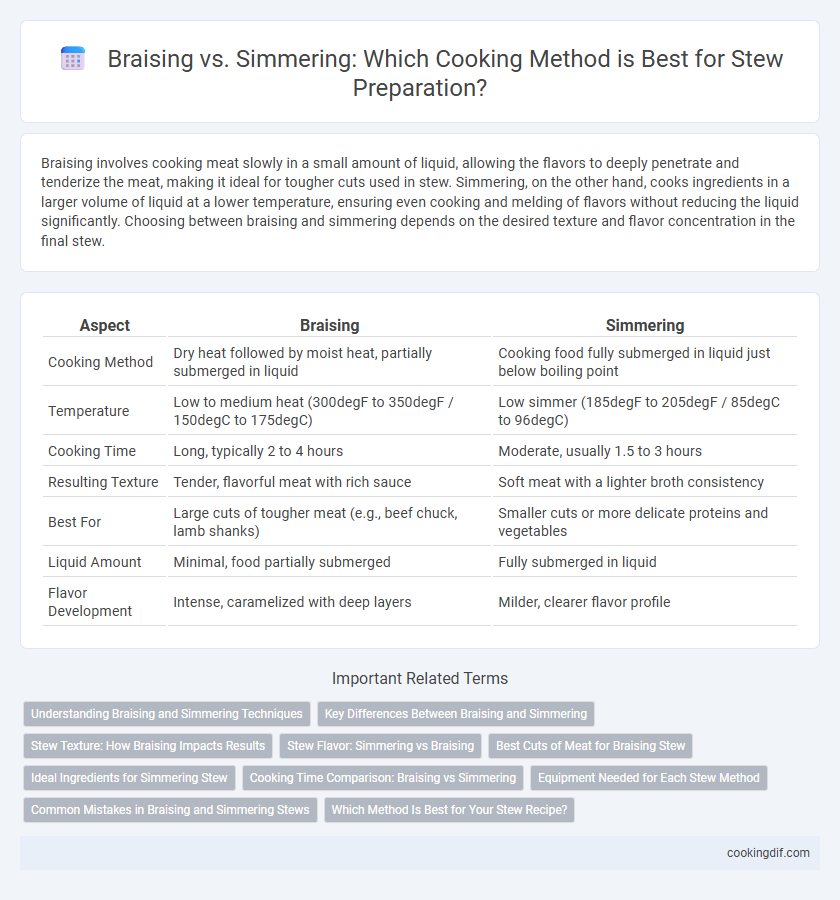Braising involves cooking meat slowly in a small amount of liquid, allowing the flavors to deeply penetrate and tenderize the meat, making it ideal for tougher cuts used in stew. Simmering, on the other hand, cooks ingredients in a larger volume of liquid at a lower temperature, ensuring even cooking and melding of flavors without reducing the liquid significantly. Choosing between braising and simmering depends on the desired texture and flavor concentration in the final stew.
Table of Comparison
| Aspect | Braising | Simmering |
|---|---|---|
| Cooking Method | Dry heat followed by moist heat, partially submerged in liquid | Cooking food fully submerged in liquid just below boiling point |
| Temperature | Low to medium heat (300degF to 350degF / 150degC to 175degC) | Low simmer (185degF to 205degF / 85degC to 96degC) |
| Cooking Time | Long, typically 2 to 4 hours | Moderate, usually 1.5 to 3 hours |
| Resulting Texture | Tender, flavorful meat with rich sauce | Soft meat with a lighter broth consistency |
| Best For | Large cuts of tougher meat (e.g., beef chuck, lamb shanks) | Smaller cuts or more delicate proteins and vegetables |
| Liquid Amount | Minimal, food partially submerged | Fully submerged in liquid |
| Flavor Development | Intense, caramelized with deep layers | Milder, clearer flavor profile |
Understanding Braising and Simmering Techniques
Braising stew involves cooking meat slowly in a small amount of liquid at low heat, allowing collagen to break down for tender, flavorful results. Simmering stews maintain a consistent temperature just below boiling, gently cooking ingredients while preserving textures and intensifying flavors. Mastering braising and simmering techniques enhances stew quality through controlled moisture and heat management.
Key Differences Between Braising and Simmering
Braising involves cooking meat slowly in a small amount of liquid, typically with the food browned first to develop deeper flavors, while simmering submerges ingredients fully in liquid at a lower temperature just below boiling. The key difference lies in braising's use of both dry and moist heat methods for tenderizing tougher cuts, whereas simmering relies solely on gentle moist heat to cook evenly. Texture and flavor intensification are enhanced through braising, making it ideal for rich, hearty stews.
Stew Texture: How Braising Impacts Results
Braising enhances stew texture by slowly cooking meat in a small amount of liquid at low heat, which breaks down collagen and creates tender, succulent pieces that melt in the mouth. Simmering, involving cooking ingredients fully submerged in liquid at a gentle heat, can sometimes result in a thinner, less concentrated texture. The controlled moisture and heat during braising concentrate flavors and produce a rich, velvety stew texture unmatched by simmering.
Stew Flavor: Simmering vs Braising
Braising enhances stew flavor by slowly cooking meat and vegetables in a small amount of liquid, allowing rich, concentrated flavors to develop through caramelization and Maillard reactions. Simmering maintains a gentle, consistent heat that preserves the delicate taste of ingredients but may result in a less intense, more diluted stew flavor. The choice between braising and simmering impacts the depth and complexity of the final stew, with braising generally producing a heartier, more robust taste.
Best Cuts of Meat for Braising Stew
Braising stew benefits from tougher, collagen-rich cuts such as chuck, brisket, and short ribs, which become tender and flavorful through slow cooking. These cuts break down slowly under low heat and liquid, enhancing the stew's richness and texture. Using prime cuts like ribeye or sirloin, better suited for quick cooking, can result in less optimal tenderness for braised stews.
Ideal Ingredients for Simmering Stew
Simmering stew ideal ingredients include tender cuts of meat like chicken thighs or pork shoulder that cook evenly without toughening. Vegetables with higher moisture content such as carrots, potatoes, and celery maintain texture and release natural flavors during simmering. Using aromatic herbs like thyme and bay leaves enhances flavor infusion while preserving ingredient integrity throughout the gentle cooking process.
Cooking Time Comparison: Braising vs Simmering
Braising typically requires longer cooking times, often ranging from 2 to 4 hours, allowing tough cuts of meat to become tender through slow, moist heat. Simmering usually involves shorter cooking durations, around 1 to 2 hours, maintaining a steady temperature just below boiling to cook ingredients gently and evenly. The extended braising period enhances flavor development and texture transformation compared to the quicker, more delicate simmering process in stew preparation.
Equipment Needed for Each Stew Method
Braising a stew requires a heavy, lidded pot such as a Dutch oven or a deep oven-safe skillet to retain moisture and evenly distribute heat during slow cooking. Simmering stews typically utilize a large stockpot or a slow cooker, which allows precise temperature control and steady low heat for prolonged cooking on the stovetop or electric appliance. Both methods benefit from sturdy, heat-resistant utensils like wooden spoons and silicone spatulas to stir without damaging cookware surfaces.
Common Mistakes in Braising and Simmering Stews
Overcooking tough cuts of meat when braising can result in a dry, stringy stew rather than a tender, flavorful dish. Common mistakes in simmering stews include maintaining too high a temperature, which causes toughening of proteins and loss of delicate flavors. Proper temperature control and precise timing are essential to achieve a rich, well-balanced stew with tender meat and vibrant vegetables.
Which Method Is Best for Your Stew Recipe?
Braising involves cooking meat slowly in a small amount of liquid at low heat, which enhances tenderness and deepens flavor, ideal for tougher cuts used in stew. Simmering requires submerging ingredients fully in liquid at a gentler heat than boiling, allowing flavors to meld uniformly throughout the stew. Choosing between braising and simmering depends on the cut of meat and desired texture, with braising preferred for rich, tender results and simmering suitable for a lighter, evenly cooked stew.
Braising vs simmering for stew preparation Infographic

 cookingdif.com
cookingdif.com